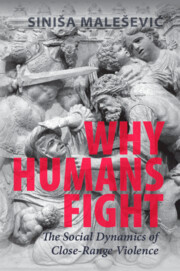Book contents
- Why Humans Fight
- Why Humans Fight
- Copyright page
- Dedication
- Contents
- Acknowledgements
- Introduction
- 1 The Body and the Mind
- 2 Profiting from Fighting
- 3 Clashing Beliefs
- 4 Enforced Fighting
- 5 Fighting for Others
- 6 Avoiding Violence
- 7 Social Pugnacity in the Combat Zone
- 8 Organisational Power and Social Cohesion on the Battlefield
- 9 Emotions and Close-Range Fighting
- 10 Killing in War
- 11 The Future of Close-Range Violence
- Conclusion
- Appendix Methodology and Data Collection
- References
- Index
1 - The Body and the Mind
Biology and Close-Range Violence
Published online by Cambridge University Press: 29 September 2022
- Why Humans Fight
- Why Humans Fight
- Copyright page
- Dedication
- Contents
- Acknowledgements
- Introduction
- 1 The Body and the Mind
- 2 Profiting from Fighting
- 3 Clashing Beliefs
- 4 Enforced Fighting
- 5 Fighting for Others
- 6 Avoiding Violence
- 7 Social Pugnacity in the Combat Zone
- 8 Organisational Power and Social Cohesion on the Battlefield
- 9 Emotions and Close-Range Fighting
- 10 Killing in War
- 11 The Future of Close-Range Violence
- Conclusion
- Appendix Methodology and Data Collection
- References
- Index
Summary
To understand the motivation for fighting it is necessary to provide some analysis of the physiological and biological make-up of human beings as a species. This chapter will utilise up-to-date research on interpersonal violence across different disciplines including anthropology, biology, cognitive evolutionary psychology, neuroscience, physiology, anatomy, and palaeontology. The focus is on the biological underpinnings of violent action and especially how human violence differs from the aggressive behaviour of other species. This chapter scrutinises and critiques the dominant essentialist interpretations which attempt to explain human behaviour in terms of biological or psychological givens. I argue that the recent experimental studies across different disciplines indicate that interpersonal violence is complex and shaped by changing structural contexts. Unlike most carnivorous mammals, human beings lack bodily entailments for aggressive behaviour and hence their increased capacity for violence has distinctly non-biological origins. To compensate for their individual physical incompetence in belligerence, human beings had to devise effective social and organisational mechanisms for violent action. Hence biology plays some role in the human capacity for aggressive behaviour, but it largely does not determine or even shape much of human violent action. Psychology is also relevant in this context but neither biology nor psychology can adequately explain the enormous contextual and historical variation that characterises human relationships with close-range violence. Instead, violent action entails the interlocking presence of organisational capacity, ideological penetration, and micro-interactional social tuning.
- Type
- Chapter
- Information
- Why Humans FightThe Social Dynamics of Close-Range Violence, pp. 16 - 44Publisher: Cambridge University PressPrint publication year: 2022

